 CHARLOTTE — For this month only, relics of several saints will be on display for veneration at St. Patrick Cathedral.
CHARLOTTE — For this month only, relics of several saints will be on display for veneration at St. Patrick Cathedral.
Father Christopher Roux, rector and pastor of the cathedral, displays the relics – some of which are from saints whose relics are not available anywhere else in the diocese – throughout November for public veneration.
The saints’ relics and their feast days are:
• St. Jean Marie Vianney – Aug. 4
• St. Francis of Assisi – Oct. 4
• Sts. Jacinta and Francisco Marto – Feb. 20
• St. Jude the Apostle – Oct.28
• 6 Passionist Saints:
o Paul of the Cross – Oct. 20
o Gabriel of Our Lady of Sorrows – Feb. 27
o Gemma Galgani - April 11
o Bl. Dominic Barberi – Aug. 27
o Maria Goretti - July 6
o Vincent Strambi – Sept. 26
• St. Stanislaus Kostka – Aug. 15
• St. Therese of the Child Jesus – Oct. 1
• St. Isidore - May 15
St. Patrick Cathedral is located at 1621 Dilworth Road East in Charlotte. For St. Patrick Cathedral’s Mass schedule and more information, go to www.stpatricks.org.
— Catholic News Herald
 CHARLOTTE — Kathy Capps and Phyllis Mennitt stroll through “Main Street” of Thomasboro Academy armed with a push wagon of hand-baked goods and a shopping cart of store-bought treats. Smiles gleam on their faces while they receive a celebrity greeting from their biggest fans, the children and teachers of Thomasboro Academy.
CHARLOTTE — Kathy Capps and Phyllis Mennitt stroll through “Main Street” of Thomasboro Academy armed with a push wagon of hand-baked goods and a shopping cart of store-bought treats. Smiles gleam on their faces while they receive a celebrity greeting from their biggest fans, the children and teachers of Thomasboro Academy.
Hugs and kisses come from all directions while teachers surround “The Angels” in search of their favorite butter pecan cupcake or double-dipped chocolate cake slice. The teachers look at “The Angels” with a smile and a shake of their head as if the cupcakes are Tylenol, and the “We Care” Team are nurses providing relief.
“When I see them, I know someone let the sunshine through the doors. These ladies have been with us for as long as I can remember, ever since I’ve been here,” claims Academic Facilitator Lori Rondo.
Pictured: Phyllis Mennitt and Kathy Capps of St. Luke Church, pictured with teacher Meghan Bernhard, are among “The Angels” who visit Thomasboro Academy on a regular basis, brightening the day for students and teachers. (Lisa Geraci |Catholic News Herald)
Each Friday morning the “We Care” Team, comprised of Phyllis Mennitt, Ann Marie Luce, Olga Monroe, Marlene Perotta, Fatima Robaina and Kathy Capps, drives from Matthews to Thomasboro Academy to serve the kindergarten to eighth-grade classes. Each teacher receives a baked item, class snacks for each student, and classroom supplies. Even the cafeteria workers and custodians get a snack. Two of the eighth-graders help distribute the snacks with “The Angels.” Some volunteers, such as Luce, go into the classroom and help the students learn to read while the team continues to distribute the snacks. The whole process starts around 11 a.m. and takes about two-and-a-half hours.
“Sometimes we laugh all the way home, sometimes we cry,” Mennitt says.
Destiny, a seventh-grade student “The Angels” have known since kindergarten, dances her way down the hallway, jumping up to give Kathy a hug and a kiss on the cheek. “I love you!” she says, clinging to Capps’ neck. Destiny does not take a treat right away, but marvels at all the choices.
The affection that Capps and Mennitt display with the children is true and palpable – the reason they have pet names such as “Mom” and “St. Luke’s Angels.”
As the middle-school students walk down the hall in a single-file line, “The Angels” call out the name of a boy. No matter how “cool” he tries to appear, the second he looks up, he melts at the sight of Capps and Mennitt, as if it was the first time he saw them as a kindergartner. His eyes grow big, a smile peeps out, and he breaks the line for a hug.
The kindergartners are adorable and love “The Angels” and their cart, too, but the older students have gotten to know “The Angels” on a different level, spending holidays, having parities, eating dinners, opening presents, sharing conversations. For them, the St. Luke parishioners are more than great bakers who come over to pass out snacks every Friday. They represent stable figures of joy and love.
For the new teachers at Thomasboro Academy, “The Angels” are a weekly reminder of love, support and thanks.
“We do this so they can look forward to something. The teachers have so much pressure on them. There is minimal parent involvement. Everyone in the community wants to tell them what to do and how to do it, but does not really understand the reality of what is truly happening inside these walls,” Capps says.
“On top of all that, they have bills and their own problems. Many of the teachers are single and young; a lot of them actually call us “mom.” The teachers and I are in constant contact even when I am not there. We are texting and emailing, chatting about school.”
“Sometimes the teachers need more hugs than the students,” says teacher Tamika Truesdale. “Everyone has their own unique relationship with Kathy.”
“She is one of kind,” she adds after having a lengthy conversation about her son and husband. “Make sure you text me those pictures,” she reminds Capps before closing her door, rice crispy treat in hand.
“Thomasboro is not the typical school,” Capps says. Despite the smiling faces of the students, dressed in their nicely pressed uniforms, Thomasboro is located in an environment that demands constant love, support, guidance and patience.
Out of the 800 students at Thomasboro Academy, 99.6 percent are classified as economically disadvantaged, and about 20 percent either homeless or in a transitional housing situation. The school received an “F” for the 2016-2017 school year, a state rating solely on end-of-grade scores and standardized test proficiency.
But the level of commitment from the administrators, teachers, community and even the students themselves tells another story – a story of hope and of overcoming obstacles.
“Thomasboro is the best and the worst experience all at the same time,” Capps says. “Some people just can’t handle it. They try to eat lunch and work in the classroom, but it was just not a fit. You can’t be judgmental. You have to roll with the punches. Whatever the child needs from the social workers, to the teachers, to the administrators, to us, we are ready.”
“This all started about 14 years ago when my daughter was in first grade and went to elementary school at Elizabeth Lane. Elizabeth Lane just adopted ‘a sponsor school,’ Thomasboro. All we knew about it was that it was a high-need school,” Capps explains.
“I started there as a lunch buddy. I ate with a girl that was also in first grade just like my girl. That first girl did it. They were all desperately craving attention. They just wanted someone to listen to their stories and hug them. I just fell in love with the whole class.”
As her relationship with the class grew stronger, she started to realize, “These pint-sized kids had adult-sized problems. Instead of ‘I need a pencil,’ it would be more like, ‘I don’t know where I’m going to sleep tonight.’ Many of the students had behavioral issues. Some were never able to apologize, they had their guard up, they were angry. Deep down they were just kids that desired to soften up and open up.
“I knew I found my place and this is where I could make a difference,” she says.
“But this is more about St. Luke than me,” she continues. “Without St. Luke it would have stayed low-key, but St. Luke has made it possible for this movement to grow. I am so awed and inspired by the whole church. During the first visit to Thomasboro, I noticed it was cold and the kids had no coats and small shoes. Straight after, I went to St. Luke’s and asked Father Jim (Hawker) if they could possibly do a clothing drive. St. Luke started collecting clothes immediately. Fourteen years later, we are still collecting supplies, food, shoes and uniforms, in a wooden crate, in the back of the church, marked ‘Thomasboro’.”
During the fall months, Kathy started casually discussing Halloween plans with the kids. The kids got a laugh out of that. They were not going trick-or-treating because the area was too dangerous. Plus, they didn’t have anyone take them. They didn’t have enough money for costumes or candy.
“It made me think – Halloween was such a little thing that kids take for granted, but these kids were really missing out on their childhood, their memories,” Capps says.
St. Luke parishioners came to rescue, and the parish youth group started making treat bags to give to the kids for Halloween.
“Then we just started adding on for each holiday. For Thanksgiving we started making sure needy families had a turkey. During Christmas, we bought every single child attending Thomasboro a gift.
“We started small, but currently, the Knights of Columbus does the food for Christmas, the youth group does the Halloween treats, Faith Formation collects hats and gloves. ‘Young at Heart’ helps with something every month, and the Hispanic community helps with our ‘We Care’ budget.
“Every ministry at St. Luke has found a way to come through for these kids,” Capps says.
“This is an amazing story, I never saw coming and it would not have happened if it was not for the help of St. Luke,” she adds.
“This whole experience has been life-changing. I am still in contact with the very first girl I sat down with for lunch, as well as other students from that class who have gone to college or are working. It is unusual for a partnership to last this long.
“It started out as volunteering and now we are family, year ’round.”
Says one teacher as he grabs a slice of pumpkin swirl cake from the wagon being pushed by “The Angels,” “They are just the lift we need around here.”
— Lisa Geraci, correspondent
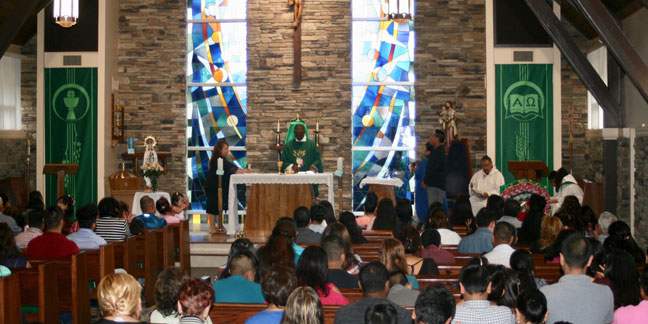 LEXINGTON — On Oct. 7, their parish’s patronal feast day, members of Our Lady of the Rosary Church gathered to celebrate the successful completion of an extensive church remodeling effort led by the parishioners themselves.
LEXINGTON — On Oct. 7, their parish’s patronal feast day, members of Our Lady of the Rosary Church gathered to celebrate the successful completion of an extensive church remodeling effort led by the parishioners themselves.
They gathered for Mass, offered by Father Ambrose Akinwande, pastor, to give thanks to God for everyone who labored to make the project a reality, and they marveled at the beauty of the refurbished nave and sanctuary.
“If I hadn’t seen this church from the outside, I would have never dreamed it was the same church,” said visitor Ted Young, who came in to help move the organ, one of the larger components of the project.
The renovation began as a straightforward beautification project for the 75-year-old church – fresh paint and new carpeting, etc. – but the scope expanded as parishioners’ enthusiasm for the idea grew.
Parishioners ended up completely remodeling the nave: removing the cry room and repositioning the organ and choir on a new raised platform at the rear of the church; installing new carpeting; repainting the walls and enhancing them with local cultured stone; and replacing the nondescript drywall ceiling with planks of southern pine that were stained a dramatic dark brown. In the sanctuary, the carpeting was replaced with a highly reflective white porcelain tile to pick up the beautiful light streaming through the tall stained glass windows behind the altar.
Parishioners chipped in with their own labor, saving thousands of dollars, and they worked for three years to raise money from special events for the project, which totals an estimated $70,000.
Gail and Kenny Capone spearheaded golf tournaments at the Asheboro Country Club and silent auctions in order for the renovation project to begin. The parish’s Hispanic community also raised funds from several festivals it hosted. The parish also used $46,520 of its “Forward in Faith, Hope, and Love” campaign money on the project.
Said Gail Capone, “We first set out to raise enough money for paint and new carpet, and look at how much more there came to be. It’s all just so amazing and so beautiful.”
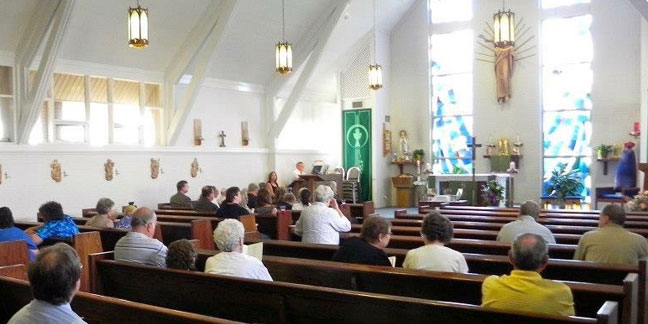 Once the parish had the money it needed for the renovation project, Father Akinwande and parishioner John Bloxsom consulted with the Diocese of Charlotte Properties Office to finalize the designs, select materials, and line up teams of stonemasons, electricians, painters and more to see the project through.
Once the parish had the money it needed for the renovation project, Father Akinwande and parishioner John Bloxsom consulted with the Diocese of Charlotte Properties Office to finalize the designs, select materials, and line up teams of stonemasons, electricians, painters and more to see the project through.
Bloxsom is grateful to Morlando for his guidance throughout the project. “His expertise was invaluable, and really made the project flow,” he said.
Parishioners did all the demolition work starting in June. They also sanded and stained all of the ceiling planks – a savings of nearly $6,000 alone. They removed all the pews for the carpet to be installed, then put them all back in place and did the final cleaning just in time for the parish’s feast day celebration.
Father Akinwande and Bloxsom said they have been simply amazed at how many people from all walks of life came together to beautify Our Lady of the Rosary Church.
“Just the fact that we can all look up at the ceiling for many years to come and say that we had a hand in that…we all stained those planks,” noted Bloxsom’s wife Karen.
“Momentum really began to build and many people stepped forward to donate additional funds in their enthusiasm and joy after seeing such good things taking place at their house of worship,” Father Akinwande said.
Bloxsom noted that the project ended up being about more than beautifying a church: it became a unifying force for the parish.
“As the project progressed, people got excited,” he said. Coming together to stain the ceiling planks, move the pews, clean the church and so much more, gave English- and Spanish-speaking parishioners the opportunity to get to know each other better, share meals, and have fun.
“It is beautiful, if I do say so myself,” he said.
— Julia Fredrica Foy Michaels, correspondent
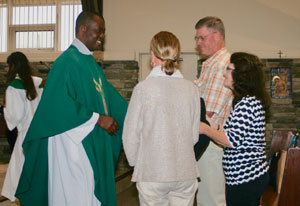
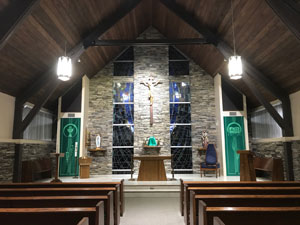
 ASHEVILLE — On a cold and rainy Saturday in downtown Asheville, parishioners from Catholic churches in the Asheville Vicariate hosted an Interfaith Prayer Service for Immigration.
ASHEVILLE — On a cold and rainy Saturday in downtown Asheville, parishioners from Catholic churches in the Asheville Vicariate hosted an Interfaith Prayer Service for Immigration.
More than 160 people from eight churches came together to pray Oct. 28 and listen to emotional stories of young immigrants who now live their lives in uncertainty, not knowing if they will be allowed to remain in the United States under the Deferred Action for Childhood Arrivals program or if they will be deported to a country they left when they were children.
People prayed for God's intercession for a just and merciful solution, and they committed themselves to supporting all immigrant families in the community.
Aztec dancers from St. Lawrence Basilica also performed during the service. The prayer service was held to show support and solidarity with the immigrant community in Asheville and to call on all people of faith to advocate for just immigration laws and policies.
— Photos provided by Nicholas Haskell
More online:
We Are Strangers No Longer: A Pastoral Statement of the Asheville Vicariate Council of the Catholic Diocese of Charlotte - 2017

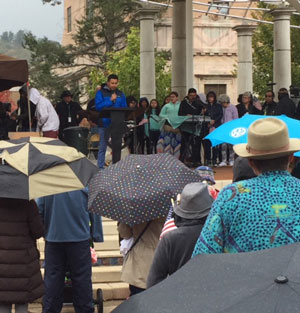
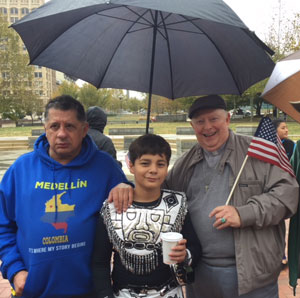
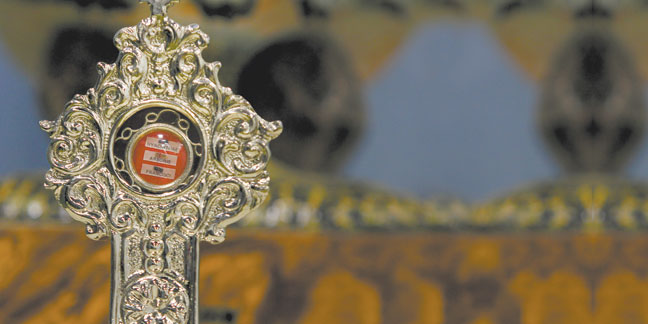 During a sudden life-threatening illness, Charles Kennedy had an army of saints at his bedside.
During a sudden life-threatening illness, Charles Kennedy had an army of saints at his bedside.
Early in the morning of Aug. 9, 2013, the 9-year-old boy suffered a hemorrhagic stroke when a blood vessel burst in his brain. He was rushed by ambulance to Carolinas Medical Center in Charlotte, where he lay in a coma as doctors rushed to treat the problem before the boy suffered permanent brain damage.
His mother, Margaret Kennedy, immediately reached out to St. Patrick Cathedral and its pastor, Father Christopher Roux, a close family friend. He arrived at the hospital quickly and anointed Charles before the boy was taken for a CT scan to investigate the cause and extent of the damage from the stroke. When he returned for a second visit, Father Roux brought a reliquary containing relics of Sts. Jacinta and Francisco, two of the shepherd children Our Lady of Fatima appeared to in 1917. A small fragment of the holm oak tree Our Lady appeared above is also encased in the reliquary.
The relics of the Portuguese saints were placed in Charles’ hand as he lay motionless in his hospital bed. Family and friends rallied to pray to Our Lady of Fatima and to the little saints for his healing. When the pressure on Charles’ brain increased, doctors performed surgery to put a shunt in his brain. The pressure in his head was dangerously high, so Father Roux instructed the Kennedys to move the relics to Charles’ head. Not long afterwards, the pressure on his brain dropped just enough that doctors could perform a critical MRI of his brain. But on the same night the MRI was done, Charles developed pneumonia. Father Roux told the family to move the relics to Charles’ chest and keep praying.
After they had moved the relics to Charles’ chest, X-rays were taken at 2 a.m. to monitor the pneumonia. The X-rays showed the pneumonia had vanished.
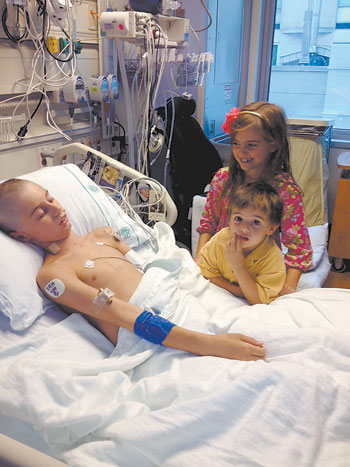 Charles Kennedy, who suffered a hemorrhagic stroke, lies in his hospital bed with the relic of St. Teresa of Calcutta taped to his arm during a visit with his family. “We’ve always had a devotion to the saints,” says Charles’ mother.
Charles Kennedy, who suffered a hemorrhagic stroke, lies in his hospital bed with the relic of St. Teresa of Calcutta taped to his arm during a visit with his family. “We’ve always had a devotion to the saints,” says Charles’ mother.
She recalled Charles receiving his first Holy Communion at the tomb of St. Cecilia in Rome on the feast of our Lady of Fatima, May 13, 2012, when the family was on a pilgrimage to Italy. During the trip they also prayed at the tombs of St. Francis and St. Clare in Assisi, and they traveled to Pollone, where they visited the summer home of Blessed Pier Giorgio Frassati, a young man who lived an exemplary life of holiness. Charles and his family prayed at the bedside where Blessed Pier Giorgio drew his last breath.
When Charles suffered his stroke, Margaret says she “called out to Mary, to Blessed Pier Giorgio, out loud,” asking for their intercession to save the life of her young son.
As Providence would have it, Father Lucas Rossi, another family friend who was assigned to St. Patrick Cathedral at the time, had a second-class relic of Blessed Pier Giorgio. He brought it to the hospital for Charles.
And the army of saints kept marching in.
The Missionaries of Charity in Charlotte also visited Charles in the hospital, bringing a first-class relic of their founder Mother Teresa to ask for her intercession with his healing.
One of Margaret Kennedy’s sisters, Dominican Sister Mary Cecilia, came from her convent in Nashville, Tenn., bearing a relic of St. Cecilia, the patron saint of musicians.
A niece, who lives in the Netherlands, had the local Carmelites of the Divine Heart of Jesus send a first-class relic of Blessed Mother Maria Teresa of Jesus, founder of the Carmel, who died in 1938. Declared venerable by St. John Paul II in 2002 and approved for beatification on May 13, 2005, by Pope Benedict XVI, she is in need of another miracle to be raised to sainthood.
Prayers for Charles were also taken to the Chapel of the Apparitions at the Cova da Iria in Fatima. A religious sister whose order helps care for the Shrine of Our Lady of Fatima and its visitors also took prayer petitions for Charles directly to the tomb of St. Francisco, seeking his intercession.
A statue of St. John Vianney was also brought to Charles’s hospital room and stayed with him throughout his hospitalization. It had been touched to the saint’s tomb by a seminarian who had traveled to France to obtain a statue of
the saint for the cathedral, as a way for parishioners to pray for an increase of priestly vocations in the diocese.
“We were begging them (all the saints) to help him,” Kennedy recalls. “Father Roux told him to talk to Mary (the Blessed Mother), to talk to Francisco because he knows of illness. He said, ‘The little shepherds are here. They will take care of you.’”
Charles lay in a coma for three weeks. He was put on a ventilator and underwent brain surgery. When doctors were finally able to reduce his medication and bring him out of sedation, his mother told Charles that she hoped the Blessed Virgin Mary had been with him.
“Francisco has been keeping me company,” Charles replied.
“Every day we prayed with the relics,” Kennedy recalls. “The whole thing was incredibly miraculous. Charles was healing so quickly. We couldn’t believe it!”
Besides a scar on his head, Charles has a slight paralysis in his left leg that requires him to wear a brace. He cannot participate in some of the athletic activities he once enjoyed, but he enjoys baseball and is able to serve at the altar and play the violin and cello.
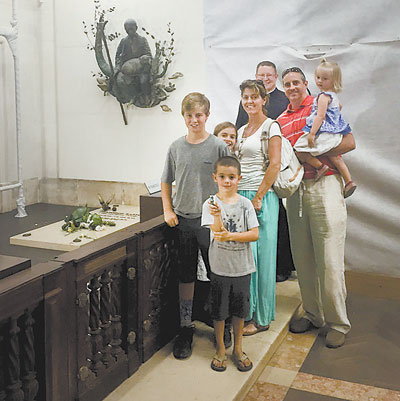 The Kennedy family made a pilgrimage of thanksgiving to Fatima, Portugal, in 2016 to thank Sts. Jacinta and Francisco for their intercession in Charles’ healing. They are pictured with their pastor, Father Christopher Roux of St. Patrick Cathedral, in front of St. Francisco’s tomb in Fatima. “A neurologist told me the week of his stroke that the part of Charles’ brain where the hemorrhage occurred is the musical part of the brain and to prepare for his musical abilities to be affected,” Kennedy recalls. “But his music teacher has been astounded at his ability to play many different instruments so well. Another miracle!”
The Kennedy family made a pilgrimage of thanksgiving to Fatima, Portugal, in 2016 to thank Sts. Jacinta and Francisco for their intercession in Charles’ healing. They are pictured with their pastor, Father Christopher Roux of St. Patrick Cathedral, in front of St. Francisco’s tomb in Fatima. “A neurologist told me the week of his stroke that the part of Charles’ brain where the hemorrhage occurred is the musical part of the brain and to prepare for his musical abilities to be affected,” Kennedy recalls. “But his music teacher has been astounded at his ability to play many different instruments so well. Another miracle!”
Eight months after Charles’ stroke, the Knights of Malta invited Margaret and Charles to go to Lourdes to pray for his continued healing. And last year the Kennedy family made a pilgrimage of thanksgiving to Fatima to thank the Blessed Virgin Mary and Sts. Jacinta and Francisco for their intercession in Charles’ miraculous healing.
Kennedy looks back on everything that happened with gratitude to God.
“All of these things are little kisses from Our Lord. These are little signs that the Lord is saying ‘I am with you.’”
Adds Charles, who’s now 14, “I’m grateful for the priests and sisters bringing so many relics to me in the hospital. Although I don’t remember my sickest days in the hospital, I know they (the blesseds and saints) were with me and praying for me.”
– SueAnn Howell, senior reporter
WHAT ARE RELICS?
Since its earliest days, the Church has recognized the importance of saints. The Creed expresses Catholics’ belief in “the communion of saints,” the common bond shared by all members of the Body of Christ, living and dead. As a tangible sign of our veneration of the saints who have gone before us, the Church supports the preservation of physical relics (pieces of bone, hair, a heart, a skull), from the saints themselves or of holy objects used in Christ’s Passion or in the lives of the saints.
Veneration of relics is practiced by the Roman Catholic and Eastern Catholic Churches and the Eastern Orthodox Church. In the Catholic and Orthodox Churches, veneration is shown outwardly by respectfully bowing or making the sign of the cross before a saint’s icon, relics or statue, or by going on pilgrimage to sites associated with saints.
Relics must not be worshiped, because only God is worshiped and adored. St. Jerome, a Doctor of the Church who lived in the late third and early fourth centuries, summarizes Church teaching this way: “We do not worship, we do not adore, for fear that we should bow down to the creature rather than to the Creator, but we venerate the relics of the martyrs in order the better to adore Him whose martyrs they are.”
Relics are divided into three classes:
- First class: items directly associated with the events of Christ’s life (manger, cross, etc.) or the physical remains of a saint (a bone, a hair, skull, a limb, etc.). Traditionally, a martyr’s relics are often more prized than the relics of other saints. Parts of the saint that were significant to that saint’s life are more prized relics.
- Second class: items that the saint owned or frequently used (a crucifix, rosary, book, etc.) Sometimes a second-class relic is a part of an item that the saint wore and is known as “ex indumentis” (“from the clothing”).
- Third class: any object touched to a first-class or second-class relic. Most third-class relics are small pieces of cloth, though in the first millennium oil was popular. Many people call the cloth touched to the bones of saints “ex brandea.” But ex brandea strictly refers to pieces of clothing touched to the body or tombs of the apostles; it is not a synonym for a third-class relic.
The sale or disposal of relics without the permission of the Apostolic See is strictly forbidden by Church law (canon 1190).
HOW ARE RELICS STORED?
Reliquaries are containers used to protect and display relics. Reliquaries can come in all shapes and sizes and are often crafted of precious metals and covered in gems, enamel or ivory.
WHY PUT RELICS IN ALTARS?
The practice of celebrating the Holy Sacrifice of the Mass over the remains of saints dates back to the first century of the Church when Christians prayed and offered Mass in the catacombs around Rome. Once Christianity was legalized throughout the Roman Empire in 313, Masses began to be celebrated publicly in churches, but Christians still wanted to offer Mass over the relics of saints as a way of expressing the connection between Christ’s sacrifice and the fruit of holiness manifested in the saints.
This tradition continues today, with many church altars containing at least one saint’s relic.
Is your patron saint nearby?
Many parishes around the Diocese of Charlotte have relics in their altars or display relics in reliquaries for veneration. The saints are truly among us in the relics of apostles, martyrs, priests, nuns, virgins, Doctors of the Church and humble children elevated to sainthood that can be found inside our churches. Is your patron saint among them?
HOW ARE RELICS PROCURED?
Parishes who wish to procure relics for their altar or for veneration in a reliquary in the church typically must apply through the bishop’s office, which then sends a formal written request to the director of the Liturgical Office in Rome, which maintains an extensive collection of saints’ relics who have died after the fifth century.
A parish can ask for a particular saint’s relics, but there is no guarantee it will receive what is requested. Only a maximum of three relics are granted for any one church, and they may not be transferred in any way.
The relics come in a small container, sealed with red thread affixed with sealing wax impressed with the seal of the Vicariate of Rome.

